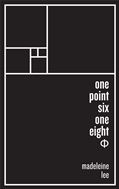reviewed by Ian Chung
Lee’s collection is promising, but hampered by its title’s misjudged significance
As a physical object, Madeleine Lee’s one point six one eight is impressive. Spreading out the collection’s accordion folds on the ground reveals that the ‘book’ is really one long spiral, and it might even be thought of as a work of ergodic literature, a term coined by Espen J. Aarseth for works that require ‘nontrivial effort […] to traverse the text’ (Cybertext—Perspectives on Ergodic Literature). A black line runs throughout one point six one eight, providing a guide for working one’s way through the collection, but the reader must still rotate the book every so often to have the text the right way up. At a time when electronic books with embedded media are being touted as ways of enhancing our reading experience, it is refreshing to see something different being attempted with a print book.
As a physical object, Madeleine Lee’s one point six one eight is impressive.
However, there is an unfortunate mismatch between the form of one point six one eight and its underlying intent. According to the collection’s brief introduction, the ‘physical design of this book plays on the theme of migration and its attendant associations which Madeleine Lee raises in her collection’. While migratory patterns call to mind the cyclical image of the ouroboros, one point six one eight actually spirals inward to its centre when laid out. Then there is the problem of the collection’s title, which derives from the golden ratio φ. To get really technical, since φ is irrational, its decimal expansion never repeats or terminates, once again running counter to the ideas of migration and return. The publisher’s website also indicates that one point six one eight should be thought of as a long poem in two sections, 13 poems of ‘migration’ followed by eight poems of ‘home’, producing a ratio that supposedly approximates φ. Except 13/8 is really 1.625, which mathematically speaking, is pretty inexact as an approximation of 1.618, so this winds up feeling more like a gimmick imposed on the collection as an afterthought.
Considered apart from these trappings though, most of Lee’s poems stand up to scrutiny. Things get off to a promising start in first poem ‘dar’, which in its first half, ‘jam’, offers up the image of ‘a seller of assorted daggers / to help cut through drivel’ in the midst of ‘the inevitable developing / economy traffic snarl’. By its second half ‘smart casual’ though, the poem devolves into an itemised list of admittedly well-observed details:
on the shady sidewalk vendors offer formal wear silk ties pink blue grey polka dots cotton shirts blue white stripes leather belts trad black or euro brown
The danger with this technique has already been identified by Neil Murphy in his review of Lee’s earlier collection fiftythree/zerothree. Done well, it shows how ‘poetry is rarely about the poet, always about the event, the moment, that it plucks from the maelstrom of living flotsam that populates a life’. On the other hand, there is the problem of ‘the event having been overwhelmed by excessive description’, running the risk of leaving a reader ‘grasping for a sense of importance’. ‘tectonic shift’ is a poem that shows Lee’s strength at the former, translating the image of rift valleys from geography into a poignant observation about human relationships:
if two people drift apart very very slowly unnoticed by the human eye a tectonic shift inching away every year after two decades they could be more than two feet apart
Yet one point six one eight also has poems like ‘southern night’, where the personification of the constellations (‘the seven sisters lie waiting’, ‘orion goes hunting’, ‘the big dipper whips the sky’) adds little beyond verbalising what has already been achieved by playing connect-the-dots with the stars to create constellations in the first place. Even the poem ‘migration’, which to judge by its title presumably must be one of the collection’s lynchpins, persists in first offering up a string of images from the Serengeti, when the poem’s crux is really the comment it makes on Euro-American tourists:
the american race breeds north and winters south its cousin breeds in european sun yet enjoys winters in africa
Although Lee’s collection begins in Dar es Salaam, the logic of migration demands that a return be made to Singapore at some point. This comes in ‘sungei buloh’, but the effect is rather jarring and reflective of neither the patterns of animal migration nor the structure of human journeys. Ironically, this abrupt shift splits the collection more naturally into 14 ‘Africa’ and seven ‘Singapore’ poems, rather than the advertised 13:8 by the publisher. Thus on the whole, one point six one eight reads like a sequence that might have been given more room to breathe in the form of more (and longer) poems, had there not been a need to conform to such mathematical constraints.
Ian Chung is a graduate of the Warwick Writing Programme. He edits Euonia Review and reviews for various publications, including Sabotage Reviews and The Cadaverine. He also watches more TV than is reasonable for one person.









